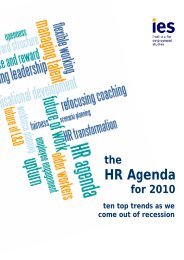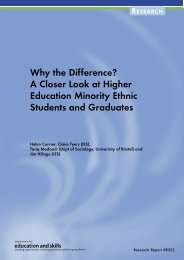Post-16 Transitions: a Longitudinal Study of Young People with ...
Post-16 Transitions: a Longitudinal Study of Young People with ...
Post-16 Transitions: a Longitudinal Study of Young People with ...
Create successful ePaper yourself
Turn your PDF publications into a flip-book with our unique Google optimized e-Paper software.
• help to progress into work/training<br />
• information<br />
• help to make decisions<br />
5.4 Unemployment/inactivity<br />
• an explanation <strong>of</strong> the options available to them.<br />
A (not insignificant) number (eight per cent) <strong>of</strong> young people<br />
who were in employment at the time <strong>of</strong> the survey had help to<br />
plan how they would be supported whilst in work or training.<br />
5.4.1 Reason for inactivity<br />
Seventeen per cent <strong>of</strong> young people taking part in the survey<br />
were unemployed or classified as economically inactive ie ill,<br />
working but not getting paid for it, looking after the family or<br />
home, or attending a day care centre. These young people<br />
were asked again about their current activity, not only in<br />
terms <strong>of</strong> what they were doing at the time but also to gauge<br />
whether they were waiting or intending to start some other<br />
activity.<br />
Table 5.20 shows that 15 per cent <strong>of</strong> these young people were<br />
waiting for a job or education/training course to start, 58 per<br />
cent were looking for work and five per cent were actually<br />
looking for an education or training course.<br />
Males seem to be more likely than females to have been<br />
looking for work at the time <strong>of</strong> the survey, as do young people<br />
<strong>with</strong>out statements <strong>of</strong> SEN compared to those <strong>with</strong><br />
statements, and young people from mainstream schools<br />
compared to those in special schools.<br />
Females, young people <strong>with</strong> statements and those who had<br />
attended a special school were less likely to be engaged in<br />
looking for work, or waiting for a job or course to start than<br />
males, those <strong>with</strong>out statements and those who had attended a<br />
mainstream school. Looking at Table 5.21, it is clear that the<br />
majority <strong>of</strong> this smaller group <strong>of</strong> young people had poor<br />
health or had caring responsibilities themselves and were<br />
unable to engage in, or look for, work, education or training at<br />
the time <strong>of</strong> the survey.<br />
<strong>Post</strong>-<strong>16</strong> <strong>Transitions</strong> <strong>of</strong> <strong>Young</strong> <strong>People</strong> <strong>with</strong> SEN: Wave 2 77

















